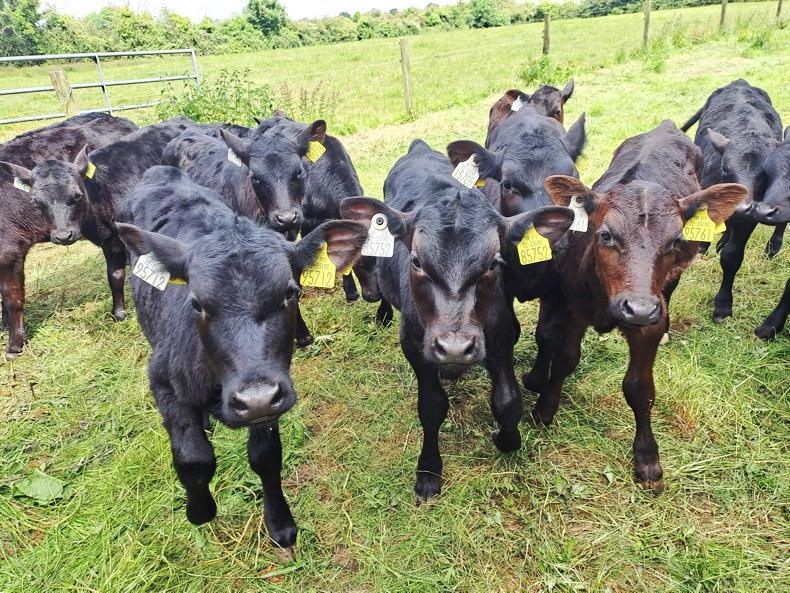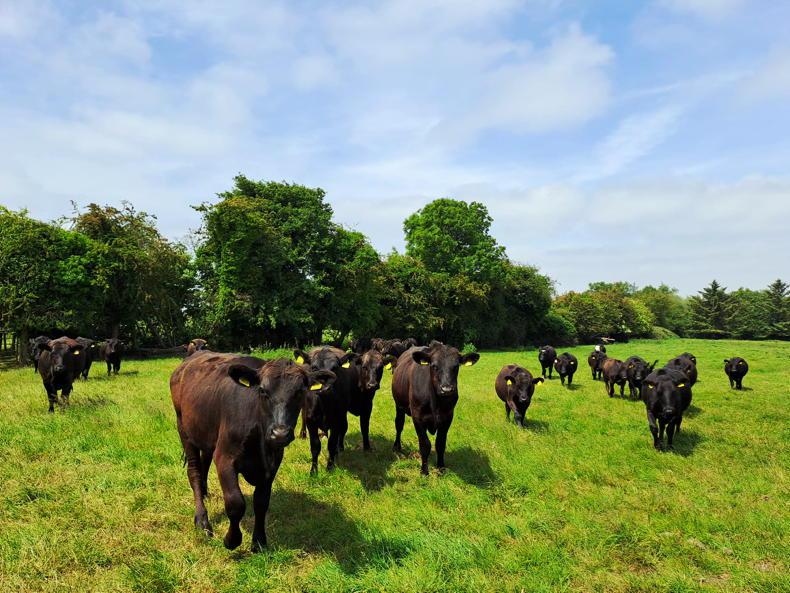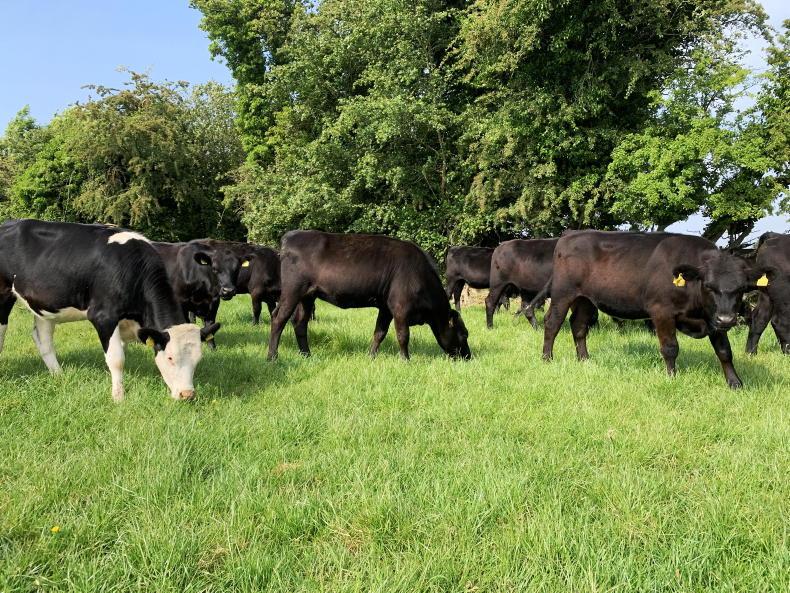Michelle Curley and her mother Patricia run a mixed suckler and dairy calf-to-beef enterprise on 80 acres in Prosperous, Co Kildare.
The suckler herd comprises a mixture of Charolais, Limousin and Hereford-cross cows.
The farm has recently switched to 100% artificial insemination - a decision the Curleys are very happy with.
Michelle comments that she has noticed a marked improvement in the quality of this year’s calves. The popular Charolais bull Orbi, marketed by Progressive Genetics, is the sire of choice.
Bull calves are castrated (rubber ring) at less than two weeks of age, with a preference to avoid any bull calves running in the herd. Progeny are sold at an average of nine to 10 months of age.
Thrive demonstration programme
For the past three years, the Curley family has been part of the Thrive demonstration programme.
The dairy-beef enterprise run on the farm consists of 30 calves, typically split 50:50 in bullocks and heifers of Angus-cross and Hereford-cross breeding. The farm is considering increasing the dairy-beef enterprise and scaling back the suckler enterprise.

Michelle Curley farms alongside her mother Patricia in Co. Kildare.
Michelle explains that grazing management and temperament are two positives for the dairy-beef enterprise. The plan is to increase the number of cattle finished on the farm as suckler numbers are reduced.
Calf rearing
For the past two seasons, calves have been purchased later in the season and typically arrived on farm in April.
As the system transitions, Michelle hopes to purchase calves at three different stages - in autumn, January and March. The aim is to have stronger calves going to grass, while also splitting the workload and having stock available for sale at different stages.

The suckler herd comprises of 30 cows
Calves are reared in stables with rubber mats on the floor in batches of six. The stables are located at the other side of the yard to where cows and their progeny are housed. This reinforces biosecurity and reduces the risk of health risks.
Calves are transitioned on to once-a-day milking as the season progresses and also offered concentrate supplementation at a rate of 1kg per head per day.

This year's calves, which have just been weaned off milk replacer.
The 2023 batch of calves are weaned off milk at this stage and continue to receive 1kg concentrate supplementation at grass. This is a cost to the system, but Michelle feels it is worthwhile in achieving high levels of gain and being in a position in year two to finish stock off grass.
Last year’s calves were purchased from three farms and a ringworm infection spread throughout the entire batch.
This year, a decision was made to purchase all calves from one farm to limit disease risk. When calves arrive on farm, they receive an intranasal live vaccine, along with a booster shot before winter housing.
Finishing system
As touched on already, the aim is to finish the cattle off grass in October to eliminate the need for a second winter indoor period. Performance over the first winter is also critical in achieving these targets. Calves are housed in slatted accommodation along with a straw lie-back, which increases cow comfort and helps improve weight gain.

These cattle will be finished off grass.
The calves are fed ad-lib silage and meal (rate depends on silage quality) across the winter.
When weighed in October, the cattle were averaging 0.7kg to 0.8kg daily liveweight gain.
They continued this level of weight gain across the winter on a diet of 77% DMD silage along with 0.5kg/day of concentrates.
They are due to be weighed in the next few weeks, when Michelle hopes they will be averaging 1kg/day in order to have them on track for finishing later in the year.
Safety
Michelle and her mother put a huge emphasis on farm safety and have invested heavily in modern cattle handling facilities to make it safer to work with the cattle for everyone involved.

Modern cattle handling facilities have been installed on the farm.
The recent installation of a new cattle crush positioned at a 45-degree angle allows people to work on the animals from both sides, with lots of working room.
It has also proved beneficial to help feed the four sets of twin calves born on the farm this year, allowing a calf to suck the cow from each side.
Drought
From Michelle’s experience of working in America, after two months of heavy rain experienced in Ireland this year, she predicted some form of a drought was imminent, so she decided to bale a field of multi-species silage, which then received one quarter of a bag of fertiliser and now has a nice cover ready for grazing.
Overall, first-cut silage yielded well, averaging at 12 bales/acre.
Soil tests are carried out every two years, with a focus on maintaining soil at the optimum pH and keeping phosphorus and potassium at index 3.
There is an active reseeding programme in place and the farm has sown some multi-species swards for the last four years.
Michelle Curley and her mother Patricia run a mixed suckler and dairy calf-to-beef enterprise on 80 acres in Prosperous, Co Kildare.
The suckler herd comprises a mixture of Charolais, Limousin and Hereford-cross cows.
The farm has recently switched to 100% artificial insemination - a decision the Curleys are very happy with.
Michelle comments that she has noticed a marked improvement in the quality of this year’s calves. The popular Charolais bull Orbi, marketed by Progressive Genetics, is the sire of choice.
Bull calves are castrated (rubber ring) at less than two weeks of age, with a preference to avoid any bull calves running in the herd. Progeny are sold at an average of nine to 10 months of age.
Thrive demonstration programme
For the past three years, the Curley family has been part of the Thrive demonstration programme.
The dairy-beef enterprise run on the farm consists of 30 calves, typically split 50:50 in bullocks and heifers of Angus-cross and Hereford-cross breeding. The farm is considering increasing the dairy-beef enterprise and scaling back the suckler enterprise.

Michelle Curley farms alongside her mother Patricia in Co. Kildare.
Michelle explains that grazing management and temperament are two positives for the dairy-beef enterprise. The plan is to increase the number of cattle finished on the farm as suckler numbers are reduced.
Calf rearing
For the past two seasons, calves have been purchased later in the season and typically arrived on farm in April.
As the system transitions, Michelle hopes to purchase calves at three different stages - in autumn, January and March. The aim is to have stronger calves going to grass, while also splitting the workload and having stock available for sale at different stages.

The suckler herd comprises of 30 cows
Calves are reared in stables with rubber mats on the floor in batches of six. The stables are located at the other side of the yard to where cows and their progeny are housed. This reinforces biosecurity and reduces the risk of health risks.
Calves are transitioned on to once-a-day milking as the season progresses and also offered concentrate supplementation at a rate of 1kg per head per day.

This year's calves, which have just been weaned off milk replacer.
The 2023 batch of calves are weaned off milk at this stage and continue to receive 1kg concentrate supplementation at grass. This is a cost to the system, but Michelle feels it is worthwhile in achieving high levels of gain and being in a position in year two to finish stock off grass.
Last year’s calves were purchased from three farms and a ringworm infection spread throughout the entire batch.
This year, a decision was made to purchase all calves from one farm to limit disease risk. When calves arrive on farm, they receive an intranasal live vaccine, along with a booster shot before winter housing.
Finishing system
As touched on already, the aim is to finish the cattle off grass in October to eliminate the need for a second winter indoor period. Performance over the first winter is also critical in achieving these targets. Calves are housed in slatted accommodation along with a straw lie-back, which increases cow comfort and helps improve weight gain.

These cattle will be finished off grass.
The calves are fed ad-lib silage and meal (rate depends on silage quality) across the winter.
When weighed in October, the cattle were averaging 0.7kg to 0.8kg daily liveweight gain.
They continued this level of weight gain across the winter on a diet of 77% DMD silage along with 0.5kg/day of concentrates.
They are due to be weighed in the next few weeks, when Michelle hopes they will be averaging 1kg/day in order to have them on track for finishing later in the year.
Safety
Michelle and her mother put a huge emphasis on farm safety and have invested heavily in modern cattle handling facilities to make it safer to work with the cattle for everyone involved.

Modern cattle handling facilities have been installed on the farm.
The recent installation of a new cattle crush positioned at a 45-degree angle allows people to work on the animals from both sides, with lots of working room.
It has also proved beneficial to help feed the four sets of twin calves born on the farm this year, allowing a calf to suck the cow from each side.
Drought
From Michelle’s experience of working in America, after two months of heavy rain experienced in Ireland this year, she predicted some form of a drought was imminent, so she decided to bale a field of multi-species silage, which then received one quarter of a bag of fertiliser and now has a nice cover ready for grazing.
Overall, first-cut silage yielded well, averaging at 12 bales/acre.
Soil tests are carried out every two years, with a focus on maintaining soil at the optimum pH and keeping phosphorus and potassium at index 3.
There is an active reseeding programme in place and the farm has sown some multi-species swards for the last four years.











 This is a subscriber-only article
This is a subscriber-only article










SHARING OPTIONS: